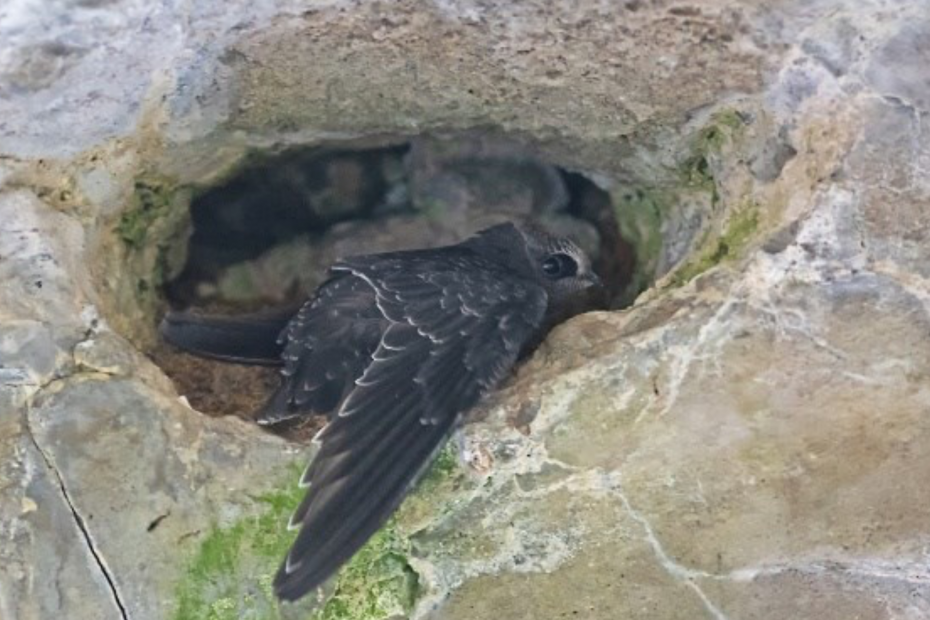Programs & Events
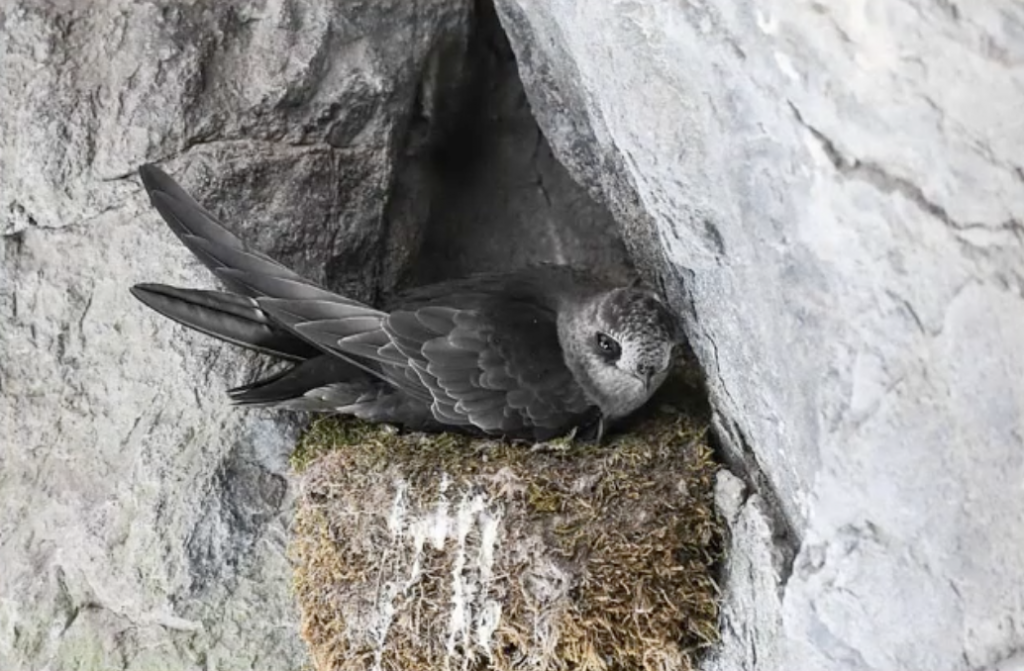
BVN continues online with our October to April program of free public presentations. These virtual events occur on the 4th Tuesday of every month at 7:30 pm. Watch the “Events” tab on the BVN website for details about how to register and find links to previous program recordings. Let’s hope one day soon you will see a note that we gather in-person gain. Until then…
Black Swifts in Banff National Park: Monitoring an Elusive Species at Risk
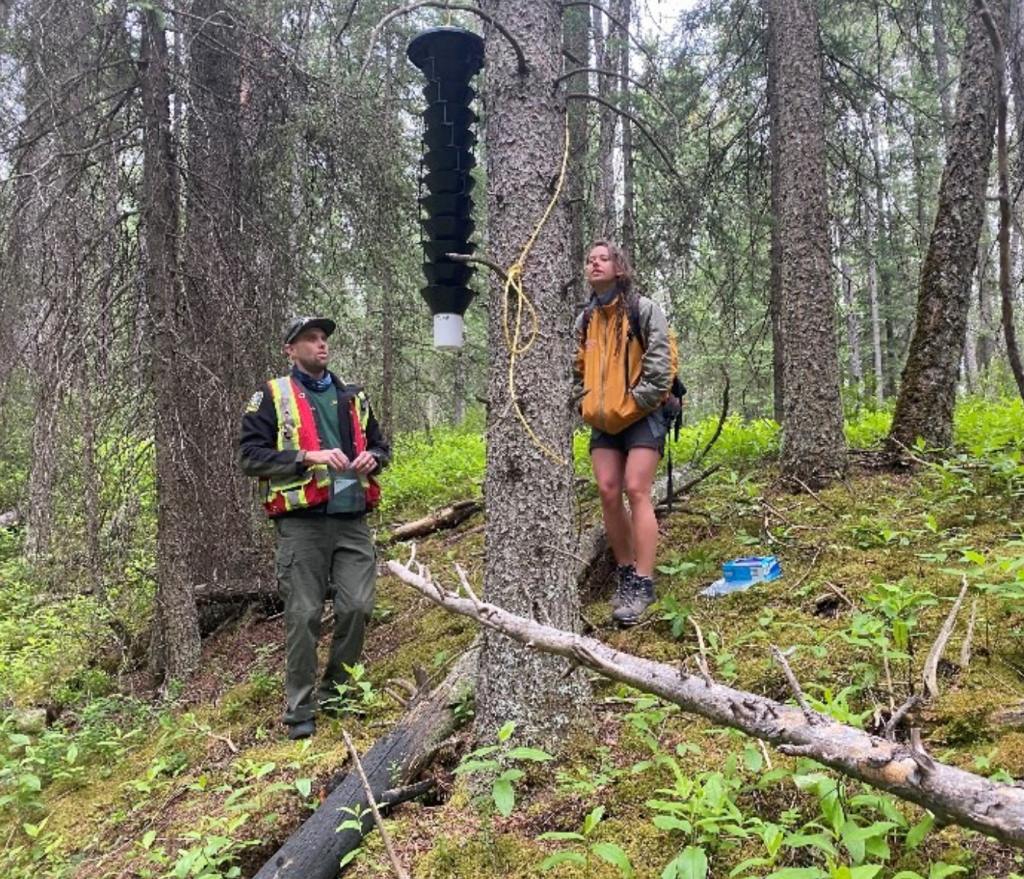
Jen Reimer || Tuesday, October 27, 2020
Click here to view the recording.
Mountain Pine Beetle and Other Influences on
Forest Ecosystems
Louis Price || Tuesday, November 24, 2020
This past summer BVN volunteered to assist Louis with monitoring Mountain Pine Beetle (Dendroctonus ponderosae) activity in the Canmore area. Louis Price is a forest health officer with Alberta Environment and Parks. He will present information on the status of Mountain Pine Beetle activity in the lower Bow Valley and possibly tell some tales of other ecosystem interactions going on around us in the forests of Southern Alberta.
The 45th Annual BVN Christmas Bird Count
Saturday, December 19, 2020
BVN will hold its 45th annual Christmas Bird Count on December 19, 2020. BVN has always been a strong believer in promoting and practicing the precautionary principle. Due to the potential for too many pandemic particles to be spread by the forced laughter from too many stale birding jokes we will not hold a group potluck and tally party. We will figure out another way to hold a winter celebration of feathered friends after the count. Please stay tuned to the BVN website and email updates for emerging details.
The Meaning of Ice
Shari Fox || Tuesday, January 26, 2021
A long-time Arctic researcher, and also a long-time Arctic resident, Shari’s book, “The Meaning of Ice: People and Sea Ice in Three Arctic Communities” won the 2014 William Mills Prize for best non-fiction polar book. The presentation will highlight how Inuit provides an important understanding not only of the Arctic environment, but of the human place within it and that to truly understand the Arctic, we have to move beyond what ice is, to what ice means.
Ya Ha Tinda Elk Herd: Insights Into Predator-prey Ecology And Conservation
Mark Hebblewhite || Wednesday, February Feb 24, 2021
The Ya Ha Tinda is one of Alberta’s most unique ecosystems, and home to some of the best habitat for Banff’s wildlife such as wolves, elk, grizzly bears. Since 2001, Mark, his students and collaborators have conducted what is now North America’s longest-running research project on elk, learning many new insights into how ungulates like elk make a living in the mountainous systems of western North America. Mark will highlight some of the most surprising and important results of this nearly 20-year research project, and illustrate how this research relates to the conservation of woodland caribou and other ungulates and their carnivore predators around the world.
Life On The Edge: Identifying Mountain Goat Habitat Hotspots In The Alpine
Laura Kroesen || Tuesday, March 23, 2021
Mountain goats are the original mountaineers. These sure-footed climbers rarely venture far from the mountain-tops. So, how do we learn to understand mountain goat behaviour? Laura’s research aims to predict high-value habitat hotspots to pinpoint foraging areas, movement corridors and bedding sites. This research will help land managers identify high-value mountain goat habitat and the movement corridors that connect them.
News & Issues
BVN does its best as an organization to speak for ecosystem protection. But we can’t do it all. Members are encouraged to follow these topics and take every opportunity to share your thoughts with land managers about the importance of protecting natural ecosystems.
Alberta Parks
The Alberta government is planning to close 20 parks and remove 164 from the Alberta Parks system. A total of 175 parks will lose protection and Albertans could lose access. What can you can do?
- Follow developments on this issue, visit the Defend Alberta Parks website.
- Send an email letter to your MLA. Handwritten letters are more memorable and more effective than template letters as they are considered a better reflection of constituent’s true opinions and can include meaningful content that cannot be ignored. (See: Lost in the Flood Below)
- Request a lawn sign. Lawn signs are effective and send a clear message to representatives that parks are important to Albertans and should be protected.
- Volunteer. Phone/text the Bow Valley Protect Our Parks coordinator Naia West: 403-493-0985.
Three Sisters Wildlife Corridors
Three Sisters Mountain Village Properties Limited (TSMVPL) has released draft Area Structure Plans (ASPs) for Three Sisters Village and Smith Creek. TSMVPL’s chairman said public engagement matters to the ownership group. Yellowstone to Yukon (Y2Y) has indicated they are not satisfied with these plans. BVN has followed this issue since the early 1990s. Please continue to show your support for Bow Valley ecosystems by reviewing Y2Ys concerns and sharing your own concerns with TSMVPL on their still-active feedback site AND then share those concerns with the Town of Canmore’s elected officials.
Increasing Use In The Ghost – Something To Watch
This summer highlighted the increasing effects of increasing human activity in the Ghost Wilderness adjacent to Banff National Park. BVN encourages its members to stay informed of this emerging issue and let your land managers know how important it is to protect ecosystems from the effects of unmanaged intrusion into wild places. Visit the Alberta Wilderness Association to get informed.
Mt. Norquay Gondola
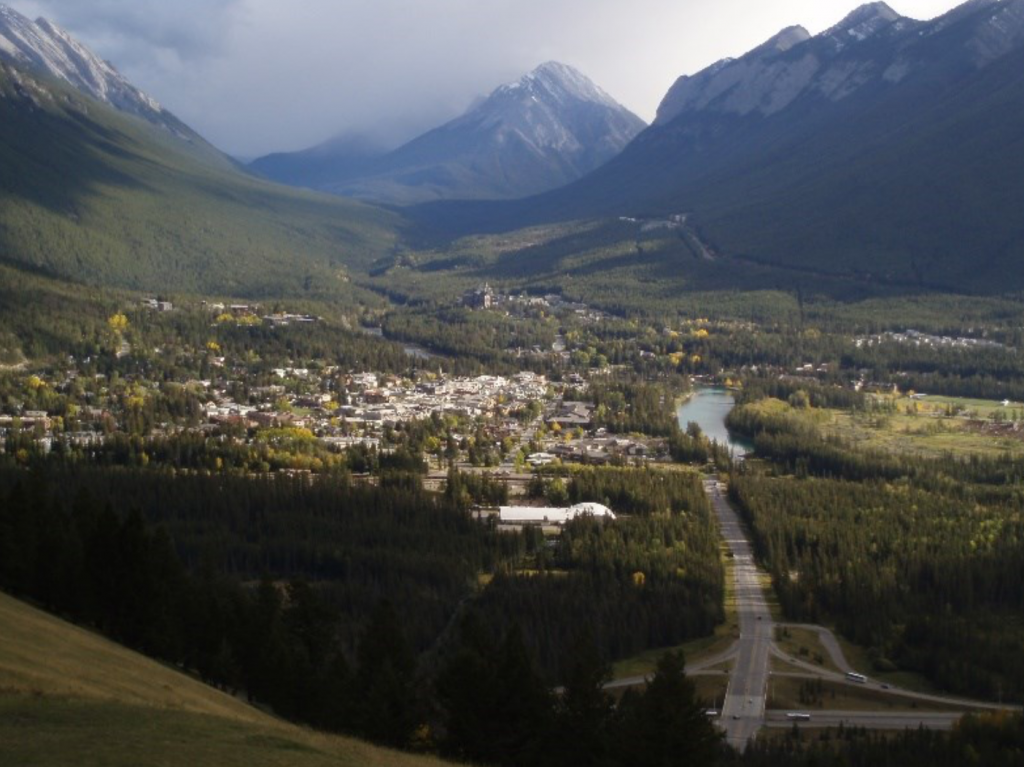
BVN continues to be concerned about the proposal to build a gondola and accessory facilities from the Banff townsite to the ski resort. There are many reasons why this expansion of development in the Town and the ski resort is not a good idea for the ecosystem and is contrary to well-established policies about the growth of human impact on Banff National Park and approved management plans. Please watch for opportunities for public comment on this proposal and contact BVN if you want more details of why we are so concerned.
Grassy Mountain Mine
On October 27 the joint federal and provincial hearing on the Grassy Mountain Mine began. The decision from this review will set a lasting precedent for the future of coal mining and environmental protection, or exploitation, for Alberta’s Eastern Slopes. Many Albertan environmental advocacy organizations believe that the Grassy Mountain Mine proposal and others threaten the ecological integrity of Alberta’s Eastern Slopes and ecosystem connectivity in the Yellowstone to Yukon corridor that we have worked so hard to protect in Banff National Park and beyond over the last few decades. There are a few places where you can get informed and find ways to support ecosystem protection from new coal development. The live hearing proceedings are being made by the Impact Assessment Agency of Canada. Also visit the Alberta Environmental Network, Alberta Wilderness Association, and the Alberta Government. Please take every opportunity to tell decision-makers you want ecosystems protected.
A Bird Feeder Bylaw And Other Domestic Intrusions
BVN would like to thank the Town of Banff for passing a bylaw that prohibits bird feeders in the townsite. This resolves a long-standing enforcement conundrum between the National Park and the Town. This bylaw also nudges us a bit closer to truly recognizing that Banff is a national park town and not just a town, like any other, that happens to be in a national park. Please contact us if you want more information about the negative effects of feeding wild birds. A Columbia Mountains Institute of Applied Ecology workshop on incidental take of bird nests provides further insights to how human activities affect bird populations. Now, if we can only stop free-ranging domestic cats from foraging for birds and small mammals in a national park.
Anû Kathâ Îpa
BVN would like to welcome the mountain name “Anû Kathâ Îpa” into our local vocabulary. Stoney Nakoda elders are hopeful the traditional name for this mountain, 1.8 kilometres northwest west of Mount Lady MacDonald, becomes fixed in Bow Valley usage. Translated in English as Bald Eagle Peak, the new name allows BVN members to recall many days watching the fall eagle migration across this peak and sharing it with other residents and visitors to the Valley. We look forward to doing more of that in future and, through this name, connecting to local indigenous culture and stories.
Is Your Mass Comment Campaign “Lost in the Flood”?
Peter Duck
Many of us have done it. Either circulated or signed-on to a mass comment campaign (MCC). Read the lead-in paragraph, type your email and click. You have done your part. But does this approach to quickly add your support to an advocacy campaign really work to influence the decision makers?
Some food for thought is offered in a paper recently published in Regulation and Governance entitled Lost in the Flood? – Agency Responsiveness to Mass Comment Campaigns in Administrative Rulemaking (Steven J. Balla, et al., 2020).
The paper is worth a read by environmental advocacy organizations who frequently use MCC campaigns and by individuals who sign-on to them. The research used data from Environmental Protection Agency decisions in the U.S. to analyze the effectiveness of MCCs. Some quick take-aways include that MCC comments are referenced less often in EPA responses compared to other comments, that regulations may not be developed in a manner consistent with comments received generally and especially for mass comment campaigns. The authors suggest that MCCs may not contain enough “relevant matter” to allow a regulatory body to consider. The latter is important given that bureaucracies may follow policy or legally binding administrative procedure laws that tie their hands by requiring them to base actions on substantive evidence and issues rather than generic commentary. In the authors’ words: “agency responsiveness occurs in proportion to the sophistication of the information contained in comments”.
There is nothing wrong with a good ‘ole mass comment campaign to get “their” attention. But this research suggests that, to be effective, the public should not rely entirely on MCCs. MCCs should be complimented by submissions from individuals and organizations that refer to specific elements of the project or proposal. The concerns expressed should be supported by reference to science and policy relating to those issues. Keep sending those thoughtful individual letters to let them know your mind!

Encountering Wildlife — Tread Lightly
Colleen Campbell
This article was written in response to a widely-publicized story of an individual following two (already anxious) male bears along the Bow Valley Parkway in a car.
Most of us thrill to the sight of another creature, large or small. Many want to capture the moment. Whether one is amateur or professional (researcher, photographer, artist, naturalist, etc.) few engage in conversations about how to visit ethically on the “turf” of other creatures, let alone other human cultures.
No matter where one is, there are ways to be a good neighbour, a good visitor — and how we ought to behave when encountering others can be summarized in one word: respect. Many of the points below could relate to visiting any culture, familiar or not — a campus, a business or a new city, any kind of park or wild area, close to home or far away.
The following list, though, is written in consideration of experiences with wildlife.
- Do not encroach on or approach any wild animal. Default to the side of caution. Use your binoculars or a big lens on your camera to capture the moment without moving towards your “quarry” or calling attention to yourself in any way.
- If an animal looks at you it has noticed you and you may be “stressing it”. Back away. Stress compromises each individual that experiences it – possibly causing it to flee from a young one that is hidden nearby, or leaving an important source of food, perhaps escaping you to run into harm on a road or by encountering another animal that will prey on it or running into an anxious encounter with someone further along a trail who is unaware of its presence.
- If you are hiking to a picnic area, to an overnight camping site, on a mountaineering or climbing excursion then regularly announce your presence to avoid surprise confrontations which are stressful for everyone involved. Most wild animals will leave the trail to avoid you.
- Stay on designated trails. Do not leave a roadside viewpoint to wander into the woods. You could inadvertently disturb a nesting area, a young animal or a den that is hidden from your view. Leaving a trail may also cause damage to sensitive habitats such as riparian areas or alpine meadows.
- If you encounter an animal that appears injured or sick, make note of species, behaviour, appearance, location, time of day and any other relevant information and notify local wildlife authorities as soon as possible. In Kananaskis, phone number is 403-591-7755, in Banff- Kootenay-Yoho is it 403-762-1470.
- If you find tracks, never follow them in the direction of travel. You may stress the animal and possibly find yourself in an antagonistic situation. Researchers may back-track an animal to discover information, perhaps a bedding site, a kill, a pile of scat or other information about the individual animal or species.
- Never leave food on the ground or a picnic table for wild animals to find. Wild animals benefit from their natural foods. Human food may actually compromise an animal’s health.
- Think about leaving your dog safely behind when you go for a hike or go camping. We are intruding on someone’s turf when we go into the woods. Your dog is an intruder. If your dog must accompany you, keep it on the leash. The reasons for this all point to safety for you, your dog, other people and any wild creature you may encounter. If you do have your dog with you, be prepared to pick up after it. Dog and human waste are attractants and pollutants and should not be left on the ground. Try to get over the “ick” factor of picking up such debris to cart out with you and dispose of it appropriately in a bin. Never throw plastic bags (full of anything) into outhouse pits.
- Try to resist the “no one else is here, I can get away with this” behaviour. Ask yourself if a stranger entered my garden, my office, my home, or looked in my window to photograph me or my belongings, how would I feel? For most of us, the answer would include words such as angry, nervous, invaded, perhaps assaulted. Let that guide you. Remember, too, how anxious many become if a bear, a bobcat, a coyote enters a human neighbourhood. We likely impose similar anxieties on wild animals.
Wildlife encounters are fleeting gifts of nature. If we behave, wild animals usually do, as well. A memorable sighting may prompt questions such as it a wolf or a coyote, a grizzly or a black bear. Watching, discovering some questions and searching for answers will enrich your experience, much more than a risky photograph that could reduce your experience to fumbling with your camera or your cell phone. Watching can lead to a prolonged experience when you share stories with others around a campfire, or write about your observations in a letter or a journal.
Of Wild Things
Weeds and Weevils
Peter Achuff
Dr. Achuff is a plant ecologist living in Canmore with many years of experience working in Canada’s National Parks and Rocky Mountain ecosystems. Peter is currently conducting research on native and invasive thistles for the Committee on the Status of Endangered Wildlife in Canada.”
Biocontrol Agent
The ecosystems, natural and human-modified, that comprise our world are networks of species interacting with each other and the physical environment. We have created or modified many ecosystems to maximize the production of things that we want, such as agricultural crops and animals. These modified ecosystems frequently are favourable habitats for species from other places. In these simplified systems, we regard species that are not part of our desired output to be pests or weeds, a weed being a plant in a place where it’s not wanted. While many of these introduced plants are well adapted to the disturbed habitats we have created, the success of many appears to be partly due to their escape from species that, in their native range, provided some control, perhaps by eating foliage or seeds. This has led to the idea of “biocontrol” in which an insect from the native range is introduced into the new area to control the introduced plant. An international scientific effort has been underway for several decades to select, screen and introduce suitable “agents.”
Thistles from Eurasia have been introduced widely in North America and have established notably in agricultural fields, range lands and other human-disturbed areas where their presence is unwelcome. Musk Thistle (Carduus nutans) has been a particularly successful invader in western range lands, especially where grazing management has not maintained healthy communities of desired forage plants. Seed Head Weevil (Rhinocyllus conicus), an insect that attacks Musk Thistle in its native range, was purposely introduced to western Canada in 1968 as a biological control for Musk Thistle.
Unfortunately, the screening process done before the weevil was introduced did not adequately evaluate whether the weevil might successfully attack native, non-target thistles. Experience of the past 50 years has shown that the weevil can attack and reproduce on native thistles and, to date, at least 22 species of native thistles in North America have been affected, many quite severely. In Alberta, the weevil is known to attack at least three of the six native species, as well as non-native thistles, including Musk Thistle, and Bull Thistle (C. vulgare). While the weevil is sometimes found on Canada Thistle (C. arvense) heads, it appears that the weevil doesn’t reproduce well on them and damage is quite limited.
The weevil is currently known in Alberta only from southern areas, mostly south of Crowsnest Pass where it attacks native thistles – Meadow Thistle (Cirsium scariosum), Hooker’s Thistle (C. hookerianum) and Wavy-leaf Thistle (C. undulatum). Of these, only Hooker’s Thistle occurs in the Bow Valley, being common along the Bow Valley Parkway. While the weevil is not yet known this far north, its effects on declining Meadow Thistle populations in southwestern Alberta have implications for Hooker’s Thistle.
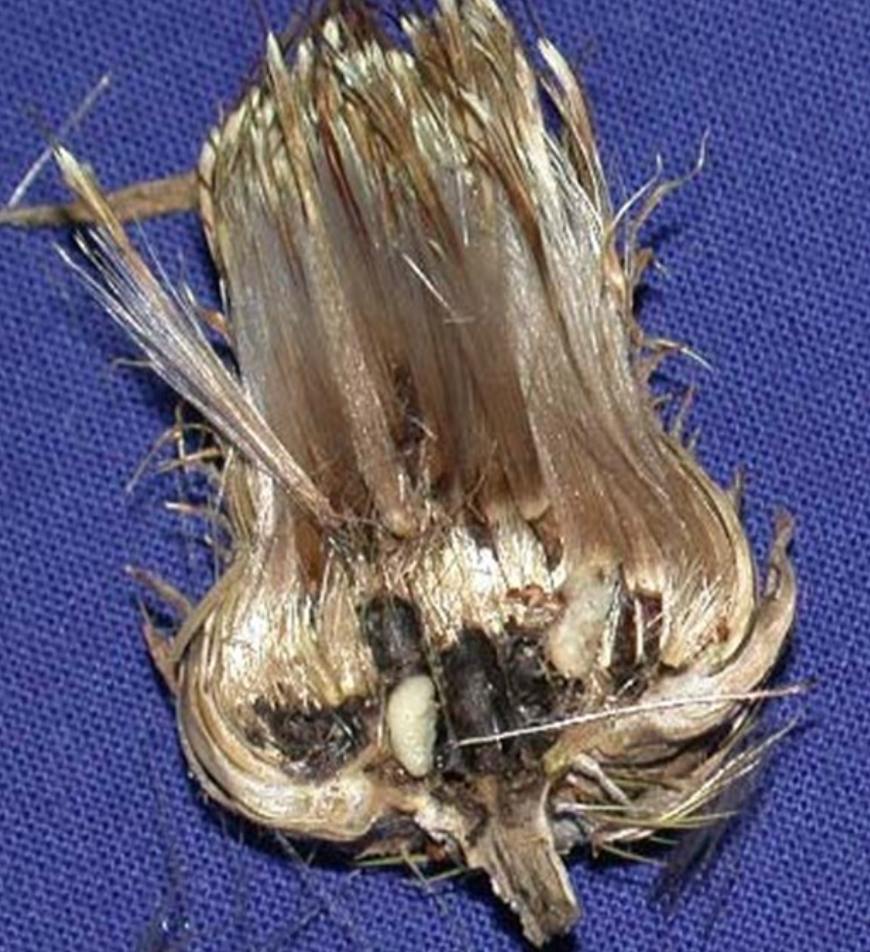
Meadow Thistle (Cirsium scariosum)
Meadow Thistle occurs in Canada as two disjunct populations: one in southwestern Alberta and adjacent BC (Flathead Valley), and one in Quebec in the Mingan Archipelago. The origin and timing of this 3500 km separation are not clear but is likely at least thousands of years old. The two Canadian populations have many similarities but only the western Canadian population is described here. Meadow Thistle also occurs in several western US states.
Meadow Thistle plants, when flowering, are typically single-stalked and up to 1 m tall from a leafy rosette. The flowers are pink to purple with a single large head at the top of the stem and several smaller heads further down the stem. The life cycle of this short-lived perennial begins when seeds germinate to form a leafy rosette, which grows larger each year for an average of about 4 years (range of 2-9 years), and then “bolts” growing a flowering stem which produces seeds. Following seed production, the plant dies and so has only one
opportunity in its life cycle to reproduce. Its habitat is generally moist meadows and open forests at middle elevations in the mountains. To establish new plants, the seeds seem to need bare mineral soil, often the result of natural disturbances (avalanche, fire, pocket gopher activity) or human activity (roads, gravel pits, well sites), and the plant grows in open sites without shade.
Why are the western populations declining? The main factor is thistle head weevil. The adult female weevil lays eggs on the thistle head, which then develop into larvae which burrow into the thistle head just below where the seeds develop. The larvae consume young seeds and the tissue essential for seed production, and thus, prevent seed production.
The life cycle timing of Meadow Thistle and the weevil make Meadow Thistle particularly vulnerable. In spring, the female weevils, which have over-wintered in the leaf litter, are looking for developing thistle flower heads for egg-laying. Meadow Thistle is the first thistle to flower in the spring and so receives the heaviest attack by the egg-laying females. Other thistles in the same area, both native (Hooker’s, wavy-leaf) and non-native (musk, bull, Canada) flower later and so are attacked less or nearly not at all, as fewer female weevils are on the prowl later in the season, most having already laid their eggs on Meadow Thistle flowers. With only one chance to produce seeds, Meadow Thistle is affected more severely than other thistles, such as wavy-leaf, in which an individual plant sets seed in more than one year. The weevil has spread throughout the range of Meadow Thistle in Alberta and BC, and is also present in U.S. thistle populations to the south. It apparently has not yet spread as far north as the Bow Valley but monitoring has been limited and the limits of its climatic tolerance are not known. Attempts to introduce the weevil to central BC have failed, perhaps due to climate. But, the effects of climatic warming could change things. There is no known way to control the weevil. The genie is out of the bottle and there’s no apparent way to put it back in.
Reduced Meadow Thistle population sizes, caused by weevils, are unlikely to reduce weevil numbers, as a classic predator-prey cycle might suggest because there are other thistle hosts, both native and non-native, that can continue to produce weevils. Might the weevils eventually drive population numbers of all thistle species down and thereby limit their own populations? Perhaps, but in the process, the most vulnerable species, such as Meadow Thistle, will be affected most severely, perhaps including local or more widespread extirpation.
Another threat is herbicide spraying, apparently by crews who do not know how to distinguish Meadow Thistle from non-native species, such as Bull or Canada Thistle. Grazing also appear to reduce Meadow Thistle populations in some areas. Rosettes, though somewhat spiny, especially when young, are readily grazed by cattle and flowering stalks are both grazed and trampled before they can produce mature seeds. Cumulative effects of all these threats are probably important.
The role of fire is unclear. Although fire likely creates suitable habitat for Meadow Thistle, recent fires in southeastern BC and southwestern Alberta, including the severe 1997 Kenow fire which swept through much of Waterton Lakes National Park, killed many Meadow Thistle plants. Being in September, the fire likely also killed many weevils, which were in the leaf litter
that was consumed by the fire. This likely resulted in areas with neither thistle nor weevil. In the post-fire reoccupation of these severely burned areas from unburned source habitat, it seems that Meadow Thistle has little chance of escaping the weevil since thistle seeds typically disperse tens of meters per year and the weevil is capable of dispersing tens of kilometers per year.
Meadow Thistle is currently being assessed by the Committee on the Status of Endangered Wildlife in Canada (COSEWIC) under the national species-at risk process. The declining population numbers and continuing unmitigated threats suggest that it might be assessed as a species-at-risk in Canada.
Hooker’s Thistle (C. hookerianum)
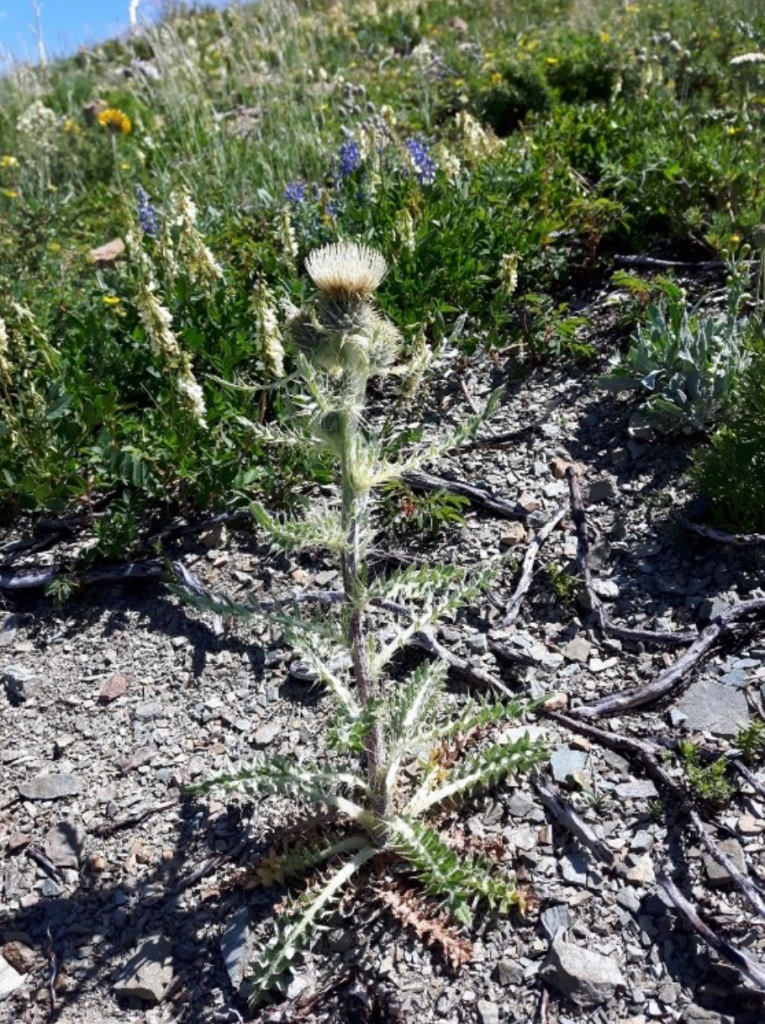
Returning to Hooker’s Thistle in the Bow Valley, Thistle Head Weevil is not currently known from the Bow Valley nor likely much north of Crowsnest Pass, although monitoring is limited. Hooker’s Thistle and other thistles, such as Bull Thistle, occur continuously north from Crowsnest Pass to the Bow Valley and could provide a movement path for the weevil. The flower of Hooker’s Thistle is densely covered with white hairs as contrasted with that of Meadow Thistle which typically has few if any, hairs. Hooker’s Thistle in southwestern Alberta is less frequently attacked by the weevil than Meadow Thistle. The hairs may present a barrier that reduces attack. Hooker’s Thistle is closely related to Meadow Thistle and has a similar life history. How various biological and climatic factors may affect how this plays out is unpredictable but there is no reason to think that the weevil has reached its full extent.
Losses – No Species is an Island
Population reduction or local extirpation of thistle populations has effects beyond the immediate, unacceptable loss of the plant itself through the network of other species that feed on thistles. Thistles are important for a wide variety of insects. Anecdotally, at least 30 species of insects and spiders have been noted on Meadow Thistle. These include bumble and leaf-cutter bees, butterflies and other flies that obtain pollen and nectar in exchange for pollination services as well as other insects that feed on sap and foliage. These insects, in turn, are food for other organisms, such as spiders, in a food web with the thistles at their base.

Monitoring Avian Productivity and Survivorship (MAPS)
Cyndi Smith
After a couple of cold and wet weather-related delays we finished off Ranger Creek MAPS mist netting season on Monday August 10. It was another day of lots of hatch year birds. A couple of mist net runs mid-morning were busy and there were lots of birds in the trees. I came up to net 5 and found 6 birds of 5 species! A nice multi-species flock of Yellow Warbler (Steophaga petechia) Yellow-rumped Warbler (S. coronata), Townsend’s Warbler (S. townsendi), Mountain Chickadee (Poecile gambeli) and White- crowned Sparrow (Zonotrichia leucophrys). After 3 years of declining capture rates this year was the 3rd highest since 1999. It would probably have been even higher had we been able to operate the first session but we missed it because we did not yet have our revised research permit with Covid-19 stipulations. In recent years that first session has not been a normal one of 6 hours, however, due to the Bow Valley Parkway spring closure to protect wildlife.
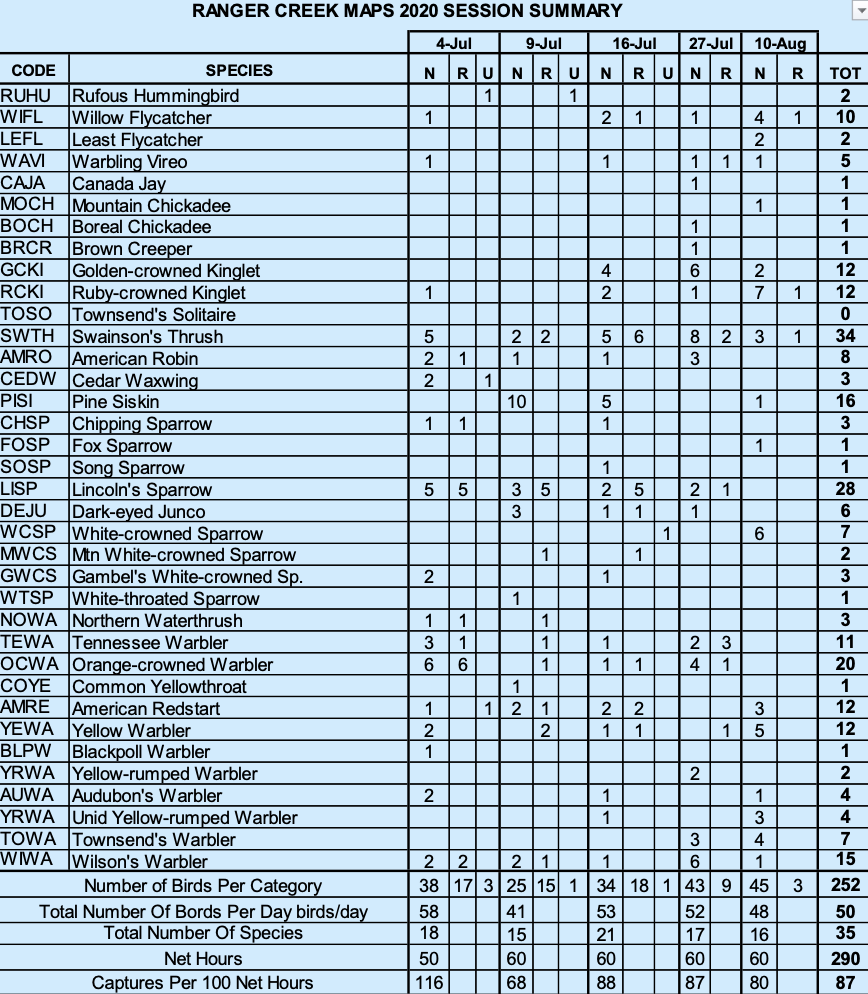
The photo (below) of the tail of an Audubon’s Warbler from our last session is interesting. The outer left tail feather (L6) is missing most of the white typically found on these feathers. White feathers seem to be structurally weaker than darker colours, and wear more rapidly. I have also seen this occur in the secondary feathers of woodpeckers.
It certainly wasn’t a “normal” year, as we could not have volunteers at the station, but we were able to keep collecting the data. I want to thank Parks Canada staff for recognizing the value of long-term monitoring and ensuring we were able to operate this year. A summary of the 2020 MAPS project data is in the table below. The full Ranger Creek MAPS Station (1999 – 2020) report may be viewed here.
HELS Update
The BVN High Elevation Localized Species database continues to be available to record your observations of Pika, Marmots, Ptarmigan and Mountain Goats. The 160 observations so far this year fall far short of the usual number of observations added to the database each year. The 2020 data, and information about becoming a HELS observer, can be seen on the BVN website on the HELS page.
What Members Read, Watch and Listen to
BOOK REVIEWS
Where There’s A Willson There’s A Way
Cyndi Smith
The title is a twist on the old saying that Jenny Willson’s late father always used, and which has become her credo. Jenny is a fictional Park Warden created by author Dave Butler in this new mystery series. Jenny is idealistic and passionate about defending Canada’s national parks and their wildlife, impatient and fed up with park bureaucrats, and dysfunctional in personal relationships. In the first novel, Full Curl, Jenny investigates three separate poaching incidents: a bighorn ram in Jasper National Park, a bull elk in Banff National Park, and a goat in Kootenay National Park. The bighorn ram poaching is based on a true incident in Wilcox Pass, and I think the other two incidents are as well, although I am not familiar with them.
In No Place for Wolverines, Jenny is seconded to work in Yoho National Park to investigate controversies swirling around a proposed ski area on the park boundary, which includes gung-ho boosterism in the local bureaucracy and corruption at the highest levels of government. After irritating and embarrassing the highest echelons of park bureaucracy, Jenny is given a choice: relocate to a small national park in eastern Canada, far away from her beloved mountains, or go on an assignment to Namibia to train enforcement staff in anti-poaching techniques. Thus, the third novel is born … In Rhino We Trust. In Namibia, Jenny joins an American colleague (whom she met during the poaching investigations) in training local officers, and fighting a well-organized rhino-poaching ring in Etosha National Park.
While there are similarities between Jenny Willson and Anna Pigeon, the fictional US National Park Ranger in Nevada Barr’s mystery series, this series is home grown. Butler’s landscapes are real, and the situations are too, although there is a lot more murder and mayhem than when I worked as a Park Warden … after all, this is fiction.
Vesper Flights
Heather Dempsey
British writer and naturalist Helen MacDonald has written a great follow-up to her 2014 memoir, H is for Hawks. Vesper Flights is a collection of 41 essays that takes the reader to the top of the Empire State Building at night to witness bird migration, on an expedition to the high altitude desert in Chile to test methods of detecting life on Mars, catch swans on the upper Thames River, learn about glow worms, what it means to be part of a flock and much, much more. The title essay describes the magic of swifts, as “creatures of the upper air”. Copies are available through the Marigold Library System. (Speaking of swifts, check out the recording of Jen Reimer’s presentation to BVN)
GETTING ENOUGH NATURE?
A Collection of Connections – Submitted by BVN Members Are you getting enough nature? What are you reading or viewing over morning coffee or tea in these times? What are your go-to nature web sites? How do you keep in touch with ecosystem issues that are important to you? Let us know how you fill your time at home with nature so we can share those ideas with others. Here is a collection of connections sent in by our members.
- Bob Milko shared news about a U.S. court, even in these times, protecting migratory birds!
- The Columbia Mountains Institute of Applied Ecology has posted the papers presented at the 2017 workshop on Avoiding Incidental Take of Bird Nests: From Flaw to Practice. Some of the articles, many relating to our region, are eye-opening stories about how human activities, including our own homes, pets and travels – kill birds. The first few presentations, such as the first by Erin Bayne (University of Alberta) entitled “How Many Birds Will I Directly Versus Indirectly Kill in my Lifetime and Which Matters More?” includes a link to an audio recording of the presentation for your listening.
- The Nature Conservancy of Canada and Nature Serve Canada have produced a report Ours To Save – The Distribution, Status and Conservation Needs of Canada’s Endemic Species. The report includes some colourful maps and identifies the Rocky Mountains as one of two areas in Canada with greater than 20 endemic species per ecosystem. A recorded 35-minute webinar is based on the report and some other interesting resources are available on the Ours To Save website.
- Alex Mowat sent in this interesting link to a story by Winnie Lee about How One Photographer Captures The Glory Of Birds In Flight – An otherworldly look at a familiar sight. The photography of Catalan photographer Xavi Bou will have looking at flock of birds in a very interesting way.
- After watching Jen Reimer’s fascinating program on Black Swifts, Joel Hagen sent us this link to a blog he posted in 2012.
- Alissa Salans and shared this link to an interesting report called Covid-19 Response and Recovery: Nature-Based Solutions for People, Planet and Prosperity.
Who to Call
You may come across situations or observations that you want to tell the authorities about. We recommend you have these phone numbers handy. Remember, cell phone coverage is spotty in the mountains so take notes if you need to move on to make a call.
- Ambulance, Fire Department, Police (RCMP): 911
- Banff Dispatch: 403-762-4506 for Park-related emergency only (avalanche, forest fire, mountain rescue, etc.)
- Banff Dispatch: 403-762-1470 for Park non-emergency (e.g. bear or large carnivore sightings, human-wildlife conflicts, injured animal, illegal park activities such as fire, camping, drones)
- Kananaskis Emergency Services 403-591-7755 for emergencies, bear, cougar and problem wildlife sightings, illegal activities. This is also the number to report a poacher. If you wish to remain anonymous while reporting a crime, phone 1-800-222-TIPS (8477)
